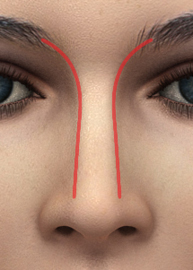Last week I attended the Advances in Rhinoplasty course held May 14th-17th at the Sheraton Chicago Hotel and Towers. This is the longest-running rhinoplasty course in the world, bringing together plastic surgeons from across the globe to discuss and debate their newest and favorite techniques.
If you are anything like my wife, you might be wondering, “how can you talk about rhinoplasty for 4 whole days?” To many patients, rhinoplasty might seem like a very simple operation. Yet most plastic surgeons consider it the most difficult procedure they perform. Rhinoplasty is hard because it embodies not only a 3-dimensional sculpting problem, but also a structural engineering problem. Perhaps the most important thing we have learned over the past 25 years is that you have to make the nose stronger. After rhinoplasty, the skin “shrink wraps” back onto the underlying cartilage and bony framework. Just like if the frame of your house isn’t strong, if the framework of the nose isn’t strong, it will collapse, thereby making the nose look unnatural and often making breathing through the nose almost impossible. Dr. Tolan and I perform a fair amount of revision rhinoplasty for patients who have undergone rhinoplasty by a different surgeon and now don’t like their “pinched” nostrils and/or inability to breathe.
One goal of rhinoplasty is to create a smooth line from the eyebrows down the sides of the nose to the nasal tip. These are called the brow-tip esthetic lines. Wide or deviated nasal bones, or a very narrow middle of the nose, can create imbalance between the top, middle and bottom of the nose. Sometimes a “wide tip” is really an optical illusion caused by a very narrow middle of the nose.
One of the more interesting talks I heard at the conference was the concept of using small burrs to sculpt the nasal bones. This is in contrast to osteotomies – “breaking the bones” – that rhinoplasty surgeons traditionally perform to straighten a broken nose or narrow a wide nose. I think that in the right patient, sculpting the bones with a small burr may lead to more predictable results, with less pain or bruising for the patient.
Another fascinating talk discussed how social media and “selfies” are changing our perception of the nose. We spend a lot more time looking at ourselves close up on cell phone or computer screens, forcing us to focus on our nose more. But prospective rhinoplasty patients must remember that when a camera lens is close to the face, it magnifies the things that are closest, including the nose. This is called the “fish-eye” effect. So, your nose isn’t as big as it looks when you are face-timing with your mother. I promise.
Most importantly, the conference re-affirmed my dedication to mastering this challenging and wonderful operation. The nose is in the center of the face, but it should not be the focus of our attention. A beautiful nose brings balance to the face and falls into the background, allowing us to focus on the eyes.


